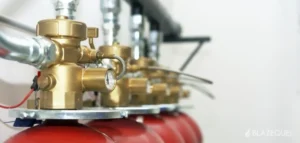
Inert Gas Fire Suppression System
Suitable for large spaces such as control rooms and manned areas
Home / Automatic Fire Fighting / Gas Fire Suppression Systems / Room Integrity Testing

Where a gas suppression system is installed, such as CO2 or Energen or any other gas medium, it is necessary for the protected room to be airtight. And this is tested every year in the form of an integrity test. This is usually carried out by the door of the suppression room being removed and a temporary door with a high-pressure, high-powered fan being installed in its place.
The high-powered fan then forces air into the room until the pressure is reached if the gas system had activated. The pressure is then measured for 10 minutes and is only allowed 10 percent seepage during that time. If it is less than this, then the room is deemed to have failed its integrity test and, and investigations must be made as to where the pressure is escaping, which is quite often through pipework or wires or cables coming out of the room and pressure escaping around them. It can be quite problematic to try and solve where these problems are, but it is a very necessary means of containing the extinguishing medium within the room.
Pressure relief dampers should be installed in the room to allow the air which is already in the room to be forced out. If this suppression system is activated, then it also needs a means of extracting the gas from the room after the fire has been extinguished. This is often done by working along with the air conditioning contractor to arrange this.
Room integrity tests are conducted to assess the effectiveness of a room’s sealing in retaining fire suppressant agents, such as clean agents or gases, used in fire suppression systems like clean agent fire extinguishers.
Contact us now to learn more about Blazequel room integrity testing service and how they can be an essential part of your fire safety plan.
A room integrity test is a procedure to measure the air-tightness of a room or enclosure where a fire suppression system is installed. It evaluates the ability of the room to retain the suppressant agent for a specified duration.
Room integrity tests ensure that the enclosed space can maintain the required concentration of the fire suppressant agent for a sufficient duration to effectively control or extinguish a fire.
Room integrity tests are typically conducted after the installation of a fire suppression system and periodically thereafter. Regular testing is essential to ensure the system’s reliability and compliance with safety standards.
The test involves pressurizing the room with air and measuring the rate at which pressure is lost. This data is then used to calculate the leakage rate and assess the room’s ability to contain the fire suppressant.
Acceptable leakage rates can vary based on the type of fire suppressant used and local regulations. Standards such as NFPA 2001 provide guidelines for permissible leakage rates.
A failed test may indicate that the room does not meet the required standards for air-tightness. This could compromise the effectiveness of the fire suppression system, and corrective measures may be necessary.
Testing frequency can depend on local regulations, but it’s generally recommended to perform room integrity tests annually or as specified by the relevant standards.
Yes, changes to the room’s structure, such as new openings or alterations, can impact the results. It’s crucial to conduct a room integrity test after any significant modifications.
Safety precautions include ensuring that the room is unoccupied during the test, following proper testing procedures, and taking necessary precautions to prevent injury or damage.
Room integrity tests should be conducted by qualified and certified professionals with experience in fire suppression systems and testing procedures.
Don’t hesitate to reach out to us, or you can easily fill out the form below. We’re here to assist you.


Suitable for large spaces such as control rooms and manned areas

Areas of high value with limited space such as computer rooms

Protect smaller areas; Suitable for protecting electrical switchgear, servers, and plant applications.
